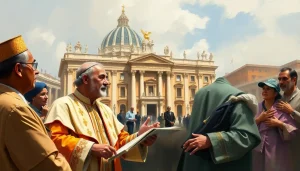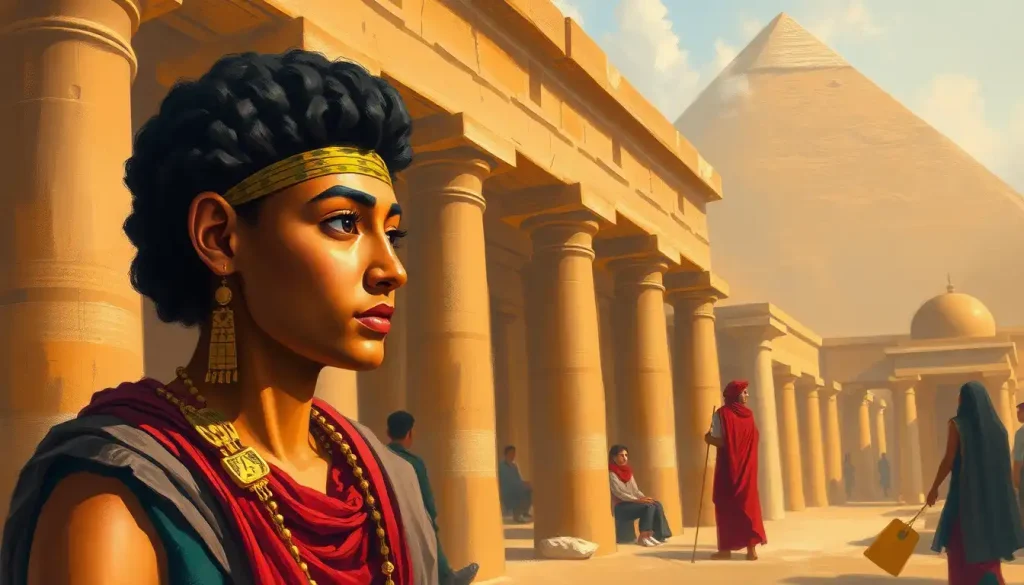Behind the ornate walls and gilded domes of the world’s smallest sovereign state lies a complex financial empire that has fascinated historians, economists, and conspiracy theorists for centuries. The Vatican, seat of the Roman Catholic Church, is not just a spiritual powerhouse but also a financial enigma that continues to intrigue and perplex the world.
For centuries, the Vatican’s wealth has been shrouded in mystery, with rumors and speculation running rampant. From tales of vast underground vaults filled with priceless artifacts to whispers of shadowy financial dealings, the topic of Vatican finances has captured the imagination of many. But what’s the real story behind the Holy See’s coffers?
The history of Vatican finances is as old as the Church itself. Since its inception, the Catholic Church has been both a spiritual and temporal power, amassing wealth through various means. This dual nature has often led to controversies and misconceptions, with critics arguing that the Church’s immense wealth contradicts its spiritual mission.
Understanding the Vatican’s wealth is crucial for several reasons. First, it sheds light on the operations of one of the world’s oldest and most influential institutions. Second, it helps us grasp the complex relationship between religion and finance. Lastly, it allows us to evaluate the Church’s ability to fulfill its spiritual and charitable missions.
Show Me the Money: Sources of Vatican Wealth
The Vatican’s wealth comes from a diverse array of sources, some more obvious than others. Let’s dive into the treasure trove and explore where all that holy moolah comes from.
First and foremost, donations from the faithful form a significant chunk of the Vatican’s income. Every Sunday, in churches around the world, collection plates are passed around, gathering contributions from devout Catholics. These donations, big and small, add up to a substantial sum that helps keep the lights on in St. Peter’s Basilica and beyond.
But the Church isn’t just relying on the generosity of its flock. The Vatican is also a savvy real estate mogul, with property holdings that would make Donald Trump green with envy. From prime real estate in Rome to properties scattered across the globe, the Church’s real estate portfolio is as diverse as it is valuable.
Speaking of valuable, let’s not forget about the Vatican Museums. Home to some of the world’s most precious artworks, including Michelangelo’s Sistine Chapel ceiling, these museums are a major tourist attraction. Millions of visitors flock to the Vatican each year, their entrance fees contributing significantly to the Holy See’s coffers.
Then there’s the Peter’s Pence collection, a special annual offering that goes directly to the Pope for charitable works. This global collection, named after the apostle Peter, allows Catholics worldwide to contribute to the Pope’s philanthropic efforts.
Lastly, like any savvy investor, the Vatican has its fingers in many financial pies. From stocks to bonds, the Church’s investment portfolio is as diverse as it is secretive. While the exact details of these investments are closely guarded, it’s safe to say that the Vatican’s financial advisors aren’t just praying for good returns – they’re actively seeking them out.
Holy Banking: The Vatican’s Financial Institutions
At the heart of the Vatican’s financial operations lies the Institute for the Works of Religion (IOR), better known as the Vatican Bank. Founded in 1942, the IOR’s official purpose is to safeguard and administer property intended for works of religion or charity. However, its history has been anything but saintly.
The Vatican Bank has been at the center of numerous scandals and controversies over the years. From allegations of money laundering to connections with organized crime, the IOR’s reputation has been tarnished more times than a brass collection plate. These scandals have led to calls for greater transparency and reform within the Vatican’s financial institutions.
In recent years, the Vatican has made efforts to clean up its financial act. Pope Francis, in particular, has pushed for greater transparency and accountability. These reforms have included external audits, closure of suspicious accounts, and stricter adherence to international banking standards. However, critics argue that there’s still a long way to go before the Vatican’s finances can be considered truly transparent.
Another key player in Vatican finances is the Administration of the Patrimony of the Apostolic See (APSA). This lesser-known institution manages the Vatican’s real estate holdings and financial investments. While it doesn’t grab headlines like the IOR, APSA plays a crucial role in maintaining the Church’s wealth.
Counting the Collection Plate: Estimating Vatican Wealth
Trying to put a precise figure on the Vatican’s wealth is like trying to count the angels on the head of a pin – it’s a task fraught with challenges and uncertainties. The Vatican’s complex financial structure, combined with its historical reluctance to disclose financial details, makes accurate assessment difficult.
In recent years, the Vatican has started publishing financial reports in an effort to increase transparency. However, these reports have limitations. They often don’t include the value of the Church’s vast art collection, real estate holdings, or other assets. It’s like trying to gauge someone’s wealth by looking at their checking account balance while ignoring their stock portfolio and real estate investments.
Expert estimates of Vatican wealth vary widely, ranging from a few billion to hundreds of billions of dollars. Some have even suggested that if the Vatican were to sell off all its assets, it could end world hunger. However, these estimates often fail to account for the fact that much of the Vatican’s wealth is tied up in non-liquid assets like art and property.
When compared to other religious organizations or nation-states, the Vatican’s wealth is significant but not necessarily extraordinary. For instance, Mormon Church wealth is often estimated to be in the same ballpark as the Vatican’s. However, it’s important to remember that the Vatican’s wealth is spread across a much larger global population of Catholics.
Spreading the Wealth: How Vatican Riches Are Used
So, what does the Vatican do with all this wealth? Contrary to popular belief, it’s not all used to gild more domes or add to the Pope’s wardrobe budget.
A significant portion of Vatican wealth goes towards funding global charitable works and missions. The Catholic Church is one of the largest non-governmental providers of education and healthcare services in the world. From running schools in impoverished areas to providing medical care in developing countries, the Church’s charitable activities are extensive and costly.
Maintaining Vatican City itself is another major expense. The upkeep of St. Peter’s Basilica alone is a monumental task, not to mention the rest of the 110-acre city-state with its museums, gardens, and administrative buildings.
The Vatican also provides financial support to dioceses and religious orders worldwide. This support is crucial for maintaining the Church’s global presence and operations, especially in areas where local donations may not be sufficient.
Lastly, a significant portion of Vatican wealth goes towards preserving its vast collection of art and cultural artifacts. The Vatican Museums house priceless works of art that require constant care and restoration. This preservation work is not just about maintaining Church property – it’s about safeguarding humanity’s cultural heritage.
Money Changers in the Temple: Controversies and Criticisms
The Vatican’s wealth has long been a source of controversy and criticism. Many argue that the Church’s accumulation of wealth goes against the teachings of Jesus, who advocated for poverty and criticized the rich. This debate on what God says about wealth continues to rage on, with passionate arguments on both sides.
Critics also point to the contrast between the Vatican’s wealth and the poverty experienced by many Catholics worldwide. They argue that the Church should do more to address economic inequality, both within its own ranks and in the broader world.
Calls for greater financial transparency have been a constant refrain in discussions about Vatican wealth. While the Church has made strides in this area, many argue that it still falls short of the level of transparency expected of a major global institution.
Over the years, there have been numerous allegations of financial mismanagement and corruption within the Vatican. From the Banco Ambrosiano scandal in the 1980s to more recent controversies involving property deals and misuse of charitable funds, the Vatican’s financial reputation has taken several hits.
In response to these criticisms, the Vatican has implemented various reforms and increased its efforts at transparency. Pope Francis, in particular, has made financial reform a key priority of his papacy. However, critics argue that these efforts are still insufficient and that more radical changes are needed.
The Bottom Line: Balancing Wealth and Faith
As we’ve seen, the topic of Vatican wealth is complex and multifaceted. It touches on issues of faith, finance, history, and ethics, making it a subject of endless fascination and debate.
The Vatican’s wealth undoubtedly provides it with significant resources to carry out its spiritual and charitable missions. From maintaining beautiful places of worship to funding global humanitarian efforts, the Church’s financial resources play a crucial role in its operations.
However, the accumulation and management of this wealth also present challenges. Balancing financial considerations with spiritual principles is no easy task, and the Vatican continues to grapple with this tension.
Looking to the future, it seems likely that Vatican finances will remain a topic of intense scrutiny and debate. As the world becomes increasingly interconnected and transparent, pressure on the Church to open its books and justify its wealth is likely to grow.
Ongoing research and public discourse on this topic are crucial. They help ensure accountability, promote transparency, and contribute to a better understanding of the complex relationship between religion and finance.
In the end, the story of Vatican wealth is more than just a tale of dollars and cents. It’s a reflection of the ongoing struggle to reconcile spiritual ideals with worldly realities, a struggle that has defined the Catholic Church for centuries and will likely continue to do so for many more to come.
As we ponder these weighty matters, it’s worth remembering that discussions about wealth and religion aren’t unique to Catholicism. From Jewish wealth to the wealth gospel movement in some Protestant churches, the intersection of faith and finance continues to be a topic of fascination and debate across various religious traditions.
Whether you view the Vatican’s wealth as a necessary tool for its global mission or a contradiction of its spiritual principles, one thing is clear: the financial empire behind those ornate walls will continue to captivate our imagination and spark important conversations about the role of wealth in religious institutions for years to come.
References:
1. Collins, R. (2014). Keepers of the Keys of Heaven: A History of the Papacy. Basic Books.
2. Pollard, J. F. (2005). Money and the Rise of the Modern Papacy: Financing the Vatican, 1850-1950. Cambridge University Press.
3. Posner, G. (2015). God’s Bankers: A History of Money and Power at the Vatican. Simon & Schuster.
4. Reese, T. J. (1996). Inside the Vatican: The Politics and Organization of the Catholic Church. Harvard University Press.
5. Nuzzi, G. (2015). Merchants in the Temple: Inside Pope Francis’s Secret Battle Against Corruption in the Vatican. Henry Holt and Co.
6. Allen Jr., J. L. (2014). The Catholic Church: What Everyone Needs to Know. Oxford University Press.
7. Zanzucchi, M. (2015). The Economy of Communion: A New Approach to the Crisis of Capitalism. New City Press.
8. Woodward, K. L. (1996). Making Saints: How The Catholic Church Determines Who Becomes A Saint, Who Doesn’t, And Why. Simon & Schuster.
9. Duffy, E. (2014). Saints and Sinners: A History of the Popes. Yale University Press.
10. Thavis, J. (2013). The Vatican Diaries: A Behind-the-Scenes Look at the Power, Personalities and Politics at the Heart of the Catholic Church. Penguin Books.












Would you like to add any comments? (optional)